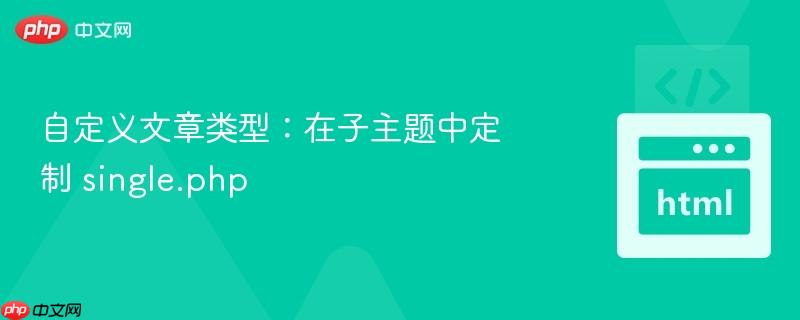
本文档旨在指导开发者如何在 WordPress 子主题中自定义自定义文章类型的单页(single.php)布局。通过创建新的模板文件并将其与特定的自定义文章类型关联,可以实现对文章展示的精细控制,从而避免直接修改父主题文件带来的风险。
创建新的模板文件:
首先,在你的子主题目录下创建一个新的 PHP 文件。 这个文件将作为你的自定义文章类型的单页模板。 建议以 single-{post_type}.php 格式命名,其中 {post_type} 替换为你的自定义文章类型的名称。 例如,如果你的自定义文章类型是 "artists",那么文件名应该为 single-artists.php。
或者,你也可以选择复制父主题的 single.php 文件到你的子主题目录,并重命名为 single-artists.php。
立即学习“PHP免费学习笔记(深入)”;
添加模板声明:
在新的模板文件顶部添加模板声明,这对于 WordPress 识别该文件至关重要。 模板声明应该包含模板名称和关联的自定义文章类型。
<?php
/**
* Template Name: 自定义艺术家文章模板
* Template Post Type: artists
*/
get_header(); // 获取头部
// 你的自定义内容
?>
<div id="primary" class="content-area">
<main id="main" class="site-main" role="main">
<?php
// 开始循环
while ( have_posts() ) : the_post(); ?>
<article id="post-<?php the_ID(); ?>" <?php post_class(); ?>>
<header class="entry-header">
<?php the_title( '<h1 class="entry-title">', '</h1>' ); ?>
</header><!-- .entry-header -->
<div class="entry-content">
<?php the_content(); ?>
</div><!-- .entry-content -->
<footer class="entry-footer">
<?php
// 添加你的自定义 footer 信息
?>
</footer><!-- .entry-footer -->
</article><!-- #post-## -->
<?php endwhile; // 结束循环 ?>
</main><!-- #main -->
</div><!-- #primary -->
<?php
get_sidebar(); // 获取侧边栏
get_footer(); // 获取页脚
?>注意: Template Name 必须是唯一的,避免与其他模板冲突。 Template Post Type 指定了该模板应用于哪个自定义文章类型。
编辑模板内容:
现在,你可以根据需要修改模板文件中的 HTML 和 PHP 代码,以定制文章的显示方式。 你可以使用 WordPress 的模板标签(如 the_title()、the_content()、the_post_thumbnail() 等)来获取文章的标题、内容、特色图像等信息。
选择模板:
在 WordPress 后台,编辑你的自定义文章类型的文章。 在编辑页面的右侧边栏,你会看到一个 "模板" (Template) 下拉菜单。 从下拉菜单中选择你创建的模板 (例如,"自定义艺术家文章模板")。
更新并查看:
更新文章,然后在前台查看该文章。 你应该看到文章使用了你自定义的模板布局。
以下是一个简单的 single-artists.php 示例,用于展示艺术家文章的标题和内容:
<?php
/**
* Template Name: 自定义艺术家文章模板
* Template Post Type: artists
*/
get_header(); ?>
<div id="primary" class="content-area">
<main id="main" class="site-main" role="main">
<?php
while ( have_posts() ) : the_post(); ?>
<article id="post-<?php the_ID(); ?>" <?php post_class(); ?>>
<header class="entry-header">
<?php the_title( '<h1 class="entry-title">', '</h1>' ); ?>
</header><!-- .entry-header -->
<div class="entry-content">
<?php the_content(); ?>
</div><!-- .entry-content -->
</article><!-- #post-## -->
<?php endwhile; // End of the loop. ?>
</main><!-- #main -->
</div><!-- #primary -->
<?php
get_sidebar();
get_footer();
?>通过以上步骤,你可以在 WordPress 子主题中轻松地自定义自定义文章类型的单页布局。 这种方法允许你对文章的展示进行精细的控制,同时保持主题的可维护性。 记得定期备份你的网站,并在进行任何重大更改之前进行测试。
以上就是自定义文章类型:在子主题中定制 single.php的详细内容,更多请关注php中文网其它相关文章!

PHP怎么学习?PHP怎么入门?PHP在哪学?PHP怎么学才快?不用担心,这里为大家提供了PHP速学教程(入门到精通),有需要的小伙伴保存下载就能学习啦!

Copyright 2014-2025 https://www.php.cn/ All Rights Reserved | php.cn | 湘ICP备2023035733号